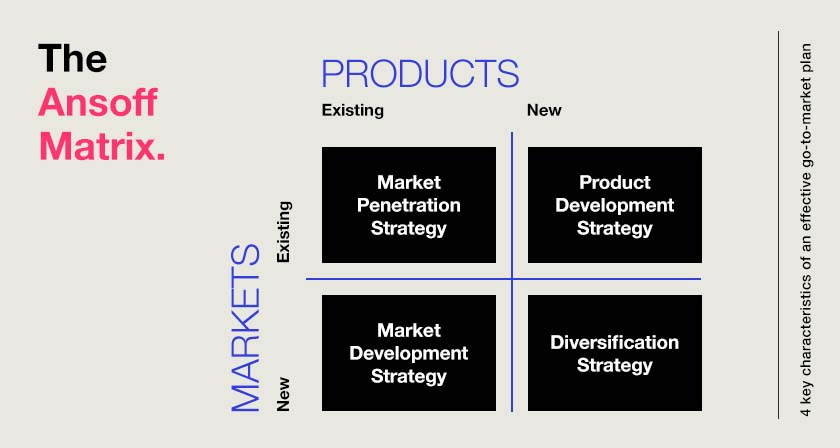
4 key characteristics of an effective go-to-market plan
Consider these points when developing your next GTM strategy.
According to Harvard Business School professor Clayton Christensen, approximately 30,000 products are launched every year and 95% of them fail.
I don’t mean to alarm you with this statistic—but it is a reminder that in today’s volatile markets, having a quality go-to-market (GTM) plan is key if you want to ensure product launch success.
So what does that look like? This article will share four key characteristics of an effective GTM plan, along with some practical tips and examples.
What are the characteristics of an effective go-to-market (GTM) plan?
It serves a timely need
A go-to-market plan is only useful if your organisation has a real need for one.
In most cases, you’ll need a GTM plan when you’re trying to bring a product to market. This includes:
- Market development: you want to introduce an existing product to a new market.
- Product development: you want to launch a new product in an existing market.
- Diversification: you want to launch a new product in a new market.
These three growth strategies carry varying levels of risk. Diversification is the riskiest since you’re releasing an untested product in an unfamiliar marketplace. If this is the case for your organisation, your go-to-market plan has to be even more meticulous and well-planned.
 Top tip
Top tip
If you’re still unsure about the direction your marketing team should be heading in, create an Ansoff matrix. This will help you explore possible ideas for each growth strategy. You’ll then be able to carry out a risk/reward assessment, which will help you select the right option (along with the goals that will underpin your GTM plan).
If you realise your organisation will benefit most from market penetration—as in, simply improving your marketing strategy rather than developing a new product and/or appealing to a new market—you do not need a go-to-market plan.
There’s a product-market fit
The best go-to-market plans take product-market fit into account.
Product-market fit refers to the degree to which a product matches strong market demand.
When developing your GTM strategy, ask yourself: what problems does your product solve for specific segments? How have you validated their needs, and what evidence do you have?
Christensen, the pioneer of the jobs-to-be-done framework, argues that people buy (or in his words, ‘hire’) products because it’ll help them complete a ‘job’ they believe needs to be done.
Now, it may seem obvious that products will only succeed if they’re needed by customers. But if past data is anything to go on, not every company ensures product-market fit before launching a product. In fact, a study conducted by CB Insights shows that 35% of startups fail because there was no market need for their offering.
Because of this reason, it’s important to dig deep into the ‘why’ and use real data to help you justify your decisions. This will involve interviewing potential customers, analysing insights from market research platforms (such as Mintel), and so on.
Top tip
How do you make sure that you’ve achieved product-market fit?
Some businesses use the 40% rule, which involves surveying customers and asking them if they’d be ‘very disappointed’ if they no longer have access to their product. And if more than 40% of them provide this response, that means they’ve satisfied a real market need.
If you own a software product, you can take this a step further and use additional online metrics to validate product-market fit. For example, low bounce rates indicate that your online users’ expectations are being met. High returning visitor rates can also suggest that your product has lasting value.
It has clearly defined KPIs
Go-to-market plans are time-bound. It’s a way to discover how to get your product in front of the most people for the least amount of money. Because of this, your KPIs must be even more clearly defined.
All businesses — and every product — are different, which means the product marketing metrics you use to measure the success of a launch will also likely be different. With that in mind there are certain KPIs are applicable to virtually every product launch, such as:
- Launch metrics
- Product adoption metrics
- Market impact metrics
Launch metrics
You can’t expect a successful product launch without a smart marketing strategy. Marketing metrics will tell you how effective your launch campaign is, which strategies are most effective, and which need to be tweaked or eliminated.
Which metrics are most important to you during a new product launch?
While the exact campaign metrics you track will depend on your larger product marketing strategy, here are the most common launch metrics to track:
- Leads generated: Generating leads as part of your product launch campaign is the first step in generating interest in your new product. Leads could be trials started, demos requested, or even thought leadership content downloaded that’s related to the new product.
- Promotional channel metrics (email, advertising): Chances are, channels like email marketing and advertising will be central to your lead generation efforts. Measure your email open rate, as well as click through rates, to measure your effectiveness in positioning your new product as part of your overall promotion strategy. If you’re using online product advertising to promote your launch, look at the costs and click through rates to measure, once again, your effectiveness at positioning and promoting this new product.
- Website traffic / page views: Be sure to measure views of all of your launch content as well, which includes website traffic or page views to new product pages, landing pages, and related content.
- News coverage: For major launches, you may also want to target PR coverage for your new release. Measure the quantity and quality of these articles or mentions to gauge your effectiveness at getting coverage.
Product adoption metrics
Once you’ve launched your product, it’s time to focus your attention on how your product is resonating with your customers. Product adoption KPIs tell you whether you have been successful in releasing and marketing a product that serves a market need —ultimately serving revenue and related business goals.
What are product adoption metrics?
Think of tracking product adoption metrics as taking a glimpse into the mind of your customers and prospects. If they are quick to flock to your newly launched product, use these KPIs to keep up momentum and steer continued interest in your product. If your product adoption rates aren’t yet where you expected them to be, use these KPIs as goals to aim for as you continue marketing your product launch.
Here are a few typical product adoption metrics to track:
- Product trials: Trials started by customers or prospects, if you’re offering this option, is a great metric for evaluating real interest in what you’ve launched. This is also a good first step in getting long-term product adoption.
- Customer usage: Setting and tracking goals around customer usage over time – not just customers trying the product but also continuing to use the product over a set timeframe – is a good measure of your product serving a customer need and your marketing effectively guiding them into that product.
- User retention: While the primary goal of your launch may be to generate awareness and interest in your new product, it is also important to retain those users to ultimately impact key business metrics like revenue.
Market impact metrics
In a competitive landscape, measuring your penetration into the market and the impact on your sales is key for measuring the success of your launch.
How do you measure market impact?
By measuring the market impact of their product, businesses are able to assess the achievement of their launch across product, marketing, and sales. Key market impact metrics to track include:
- Revenue: If you are charging for this new product separately, revenue will be a critical KPI to measure the success and impact of your latest product launch. This is how customers show you that you have truly delivered value with your new product release.
- Market share: Odds are there are many products like yours in the market. It’s important to know what portion of the market for that product your business is capturing. The market share KPI, in other words, tells you how well your product is performing compared to your top competitors.
- Competitive win rate: Another measure of your success in overcoming competitors in the market is your competitive win rate. If your new product competes head-to-head with existing solutions in the market, your competitive win rate should increase with a successful launch.

It takes a holistic approach
Go-to-market plans become holistic when you take the following three pillars into account: the customer, the competitor, and the company.
It’s easy to make the mistake of not acting on data. In every step of your GTM blueprint, consider your competitors and target personas. How does what you know about them justify your decisions on pricing, messaging, promotion tactics, and so on?
What’s more, developing a go-to-market strategy shouldn’t just be a marketing exercise; it should be a cross-department effort. After all, the way each department operates can affect how fast (or slow) a prospect converts into a customer—so they should all have a say.
Your sales department, in particular, should be involved when selecting your sales strategy. For example, will your organisation focus on inbound or outbound sales? What types of sales models will you pick?
Your customer service department must be informed about your brand positioning and messaging—both key components of a GTM plan. Otherwise, support agents may not be able to effectively and consistently convey them during their interactions with customers.
And lastly, your IT team should know about all the processes and workflows that your GTM plan will require, so your technicians can ensure that they’re enabled—and not hindered—by technology.
Top tip
Some businesses use the OKR (Objectives and Key Results) framework to achieve cross-department alignment.
It works by organising employees around common significant objectives, which are supported by key results (measurable success criteria) and initiatives (activities each department can do to help move forward the key results and achieve the objective). To implement this framework, you must appoint an ‘ambassador’ whose role is to make sure that everyone is properly trained, engaged, and has access to ongoing support.
 Some examples of go-to-market (GTM) plans
Some examples of go-to-market (GTM) plans
Example 1: Mailchimp
Email automation company Mailchimp did not introduce their product with the subscription model they currently use today. In fact: in the beginning, they targeted SMBs with limited budgets by offering their product for free (which generated a lot of word-of-mouth recommendations). Because of this, they were able to keep costs low and customer acquisition a straightforward process, which in turn allowed them to develop more sophisticated features and incorporate more lucrative pricing models down the line.
Since the rise of product-led growth, more companies than ever before are launching a freemium model. Whether you call it freemium, free trial, or some sort of hybrid, for the purposes of this article, it doesn’t matter. They’re all a way of being product-led and give your users an easy way to try before you buy.
Example 2: Upscope
At first glance, screen-sharing software company Upscope had a generic product targeted at common users. However, their go-to-market strategy deliberately targeted technical support specialists and customer success agents, who both share one pain point: the hassle of screen-sharing. This comes across in their brand positioning and messaging. Since then, the company has scaled and now offers integrations with live chat companies like Intercom and Zendesk.
Example 3: TaxJar
A highlight in TaxJar’s GTM plan is their content strategy. To build the tax automation company’s authority and credibility in the eyes of its target audience (business owners and executives), they chose to publish informative eGuides about relevant topics, such as compliance and sales tax. As there was a lack of authoritative content at the time, this gave them a big competitive edge. Since developing a resource centre on their website, they’ve been able to position themselves as the go-to source for sales tax information.
Conclusion
Every go-to-market plan is slightly different; they should accurately reflect the nature of your product, so variations are inevitable. However, every effective one fulfils the following criteria: they take a holistic approach, support your organisation’s broader strategic goals, consider product-market fit, and contain clear KPIs. By incorporating these points into your GTM plan, you’ll increase the likelihood of your product launch’s success.
Read the latest positioning trends and insights.
Tap into our brand and product positioning, storytelling, and creative expertise to inspire your next strategic move.

